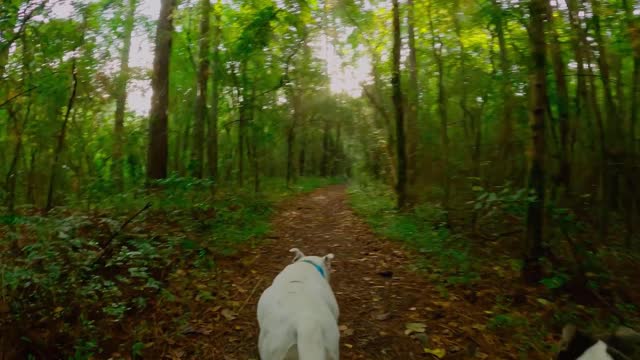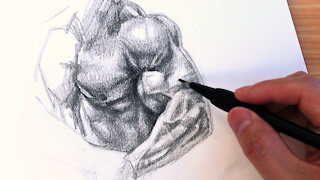Premium Only Content

Evolution of facial muscle anatomy in dogs.
Evolution of facial muscle anatomy in dogs.
Dogs have been shaped during the course of domestication both in their behavior and in their anatomical features. Here we show that domestication transformed the facial muscle anatomy of dogs specifically for facial communication with humans. A muscle responsible for the intense elevation of the inner eyebrow is uniformly present in dogs, but not in wolves. Behavioral data show that dogs also produce the eyebrow movement significantly more frequently and with greater intensity than wolves, with higher intensity movements produced exclusively by dogs. Interestingly, this movement enhances pedomorphism and resembles an expression that humans produce when they are sad, so its production in dogs may trigger a caring response. Our hypothesis is that the expressive eyebrows of dogs are the result of selection based on the preferences of humans.
Domestication turned wolves into dogs and transformed both their behavior and their anatomy. Here we show that in just 33,000 years, domestication transformed the facial muscle anatomy of dogs specifically for facial communication with humans.
Behavioral data, collected from dogs and wolves, show that dogs produce eyebrow movement significantly more frequently and with greater intensity than wolves, with higher intensity movements produced exclusively by dogs. Interestingly, this movement enhances pedomorphism and resembles an expression that humans produce when they are sad, so its production in dogs may trigger a nurturing response in humans.
The dog-human bond is unique and diagnostic of the evolution of human cultures. Dogs were domesticated more than 33,000 years ago, and during this period, selection processes have shaped their anatomy and behavior and made them man's best friend. Most notable among dogs' behavioral adaptations, as a result of selection during domestication, is their ability to read and use human communication in a way that other animals cannot . Dogs are more adept at using human communicative cues, such as pointing gestures or gaze direction, even than the closest living relative of humans, chimpanzees, and also than their closest living relatives, wolves or other domesticated species . Recent research suggests that eye contact between humans and dogs is crucial for dog-human social interaction. Dogs, but not wolves, establish eye contact with humans when they cannot solve a problem on their own . Eye contact also helps dogs know when communication is relevant and directed at them, because dogs tend to ignore human pointing gestures when human eyes are not visible . Dogs, but not wolves, seem to be motivated to make eye contact with humans from a young age , and dogs' motivation to make eye contact with humans seems to be an indicator of the level of attachment between humans and dogs . Thus, the mutual gaze between dogs and humans seems to be a mark of the unique relationship between both species during human cultural evolution.
They showed that between dogs and humans (but not wolves and humans), mutual gaze seems to lead to an oxytocin feedback loop analogous to that between human mothers and infants. Oxytocin plays a key role during affiliation behaviors in mammals and during the onset of maternal behavior and mother-infant attachment . Similarly, mutual gaze between dogs and humans seems to trigger an increase in oxytocin in both species, which increases the motivation to make eye contact . Since this cross-species oxytocin loop can be found in dogs and humans, but not between dogs' closest living relative (the wolf) and humans, selection processes during domestication must have played an important role in which dogs hijacked the human grooming response . The most likely evolutionary scenario is that the ancestor of dogs must have, to some extent, expressed traits that elicited a caring response from humans. Humans then consciously or unconsciously favored and therefore selected for these features, leading to the analogous adaptations we see in dogs today.
-
 23:18
23:18
Art of Wei
3 years agoHow to Draw and Shade Muscle Anatomy
31 -
 1:46:14
1:46:14
Kim Iversen
10 hours agoTrump to Zelenskyy: 'You're Gambling with World War III'
86.3K131 -
 55:28
55:28
Glenn Greenwald
11 hours agoGlenn Reacts to Trump-Zelensky Exchange and Takes Q&A from our Members | SYSTEM UPDATE #415
134K235 -
 4:26:54
4:26:54
Nerdrotic
13 hours ago $38.63 earnedMarvel PANIC MODE! Kathleen Kennedy GONE?! Hollywood DEI Dead | Friday Night Tights 342 Nick Freitas
145K39 -
 1:30:03
1:30:03
Flyover Conservatives
1 day agoZelensky Fail... God Called IT!; From Prison to the White House: Angela Stanton King’s Unbelievable Redemption Story | FOC Show
58.7K6 -
 1:06:14
1:06:14
IsaacButterfield
13 hours ago $2.39 earnedFree Speech Is Dead | Did Trump Go Too Far? | Sexist Job
49.7K21 -
 1:02:59
1:02:59
Sarah Westall
16 hours agoEpstein Files, Dueling Cabal Factions and Gold from Ancient Civilizations w/ Dave Hodges
77.9K23 -
 3:15:08
3:15:08
I_Came_With_Fire_Podcast
14 hours ago“Trump-Zelensky BEATDOWN | Europe BUILDS MUSCLE | NEWSCUM Podcast”
22.3K2 -
 41:25
41:25
CatfishedOnline
14 hours ago $2.21 earned23-Yr-Old Drove 2,650 Miles to Meet Online Girlfriend in Romance Scam
44K6 -
 1:56:18
1:56:18
Bare Knuckle Fighting Championship
2 days agoCountdown to BKFC FIGHT NIGHT ALBUQUERQUE & FREE LIVE FIGHTS!
38.4K2